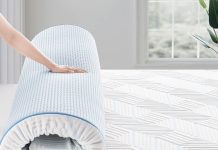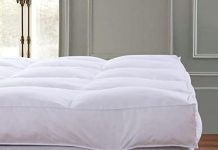Pillows are an essential component of a good night’s sleep, providing support and comfort as we rest. However, many of us may not be aware of when it’s time to bid adieu to our beloved pillows and welcome in fresh ones. In this article, we will explore the importance of replacing pillows regularly and guide you on how to determine the optimal time for a pillow upgrade. So, if you find yourself pondering over the idea of when to let go of your trusty pillow companions, look no further – we’ve got you covered!
This image is property of time.com.
Review contents
Factors Affecting the Lifespan of Pillows
Type of Pillow Fill
The type of fill used in a pillow is one of the key factors that can affect its lifespan. Different fills have different levels of durability, comfort, and support. For example, synthetic pillows are typically less durable and may need to be replaced more frequently compared to natural fillings like down or feather pillows. Memory foam pillows, on the other hand, are known for their longevity and can last for several years with proper care.
Usage Frequency
The frequency of pillow usage can also impact its lifespan. Pillows that are used every night will experience more wear and tear compared to pillows that are used less frequently. The constant pressure and movement can cause the fill to break down over time, leading to a loss of support and comfort.
Quality of Pillow
The quality of the pillow itself plays a significant role in determining its lifespan. Higher quality pillows are often made with better materials and craftsmanship, which can make them more durable and long-lasting. Investing in a high-quality pillow can save you money in the long run, as you won’t need to replace it as frequently.
Sleeping Habits
Your sleeping habits can also impact the lifespan of your pillows. Different sleep positions put varying levels of pressure on the pillow, which can lead to uneven wear and tear. For example, side sleepers tend to put more weight on their pillows compared to back or stomach sleepers. Understanding your sleeping habits can help you choose a pillow that is better suited to your needs and can withstand the pressure over time.
Signs It’s Time to Replace Your Pillows
Visible Signs of Aging
One of the most obvious signs that it’s time to replace your pillows is visible signs of aging. Look for signs such as flattened areas, lumps, or clumps in the fill. These signs indicate that the pillow has lost its original shape and support, making it less effective in providing a comfortable sleep surface.
Lack of Support
If you find that your pillow no longer provides the same level of support as it did when it was new, it’s a clear indication that it needs to be replaced. A pillow that no longer supports your head and neck properly can lead to discomfort and even pain during sleep.
Allergies or Breathing Issues
If you develop allergies or experience breathing issues, your pillows could be the culprit. Over time, pillows can accumulate allergens such as dust mites, mold, and pollen, which can trigger allergies or worsen existing respiratory conditions. If you find that your allergies or breathing problems are persisting despite cleaning your pillows, it may be time to replace them.
Persistent Neck or Shoulder Pain
Waking up with neck or shoulder pain consistently is a sign that your pillow is not providing adequate support. A pillow that is too flat or too firm can cause misalignment of the spine and lead to discomfort. If you experience persistent pain, it’s worth considering replacing your pillow with one that better suits your sleeping position and provides proper support.
Unpleasant Odors
If your pillow emits unpleasant odors even after washing, it’s a sign that it’s time for a replacement. Over time, pillows can accumulate sweat, body oils, and other substances that can cause them to develop a stale or musty smell. While washing can temporarily alleviate the odor, if it persists, it’s best to invest in a new pillow.
Unwashable Pillows
Some pillows are not designed to be washed, and their lifespan is determined by how long they can maintain their shape and support. If you have an unwashable pillow and notice signs of wear or feel that it’s no longer providing the same level of comfort, it’s a good indication that it’s time to replace it.
Recommended Pillow Replacement Frequency
Synthetic Pillows: 1-2 Years
Synthetic pillows typically have a shorter lifespan compared to other types of pillows. With regular use, synthetic pillows can start to lose their shape and support within a year or two. If you notice visible signs of aging or feel a lack of support, it’s time to replace your synthetic pillow.
Down or Feather Pillows: 2-3 Years
Down or feather pillows are known for their comfort and softness. However, these types of pillows may need to be replaced every two to three years, especially if they start to lose their loft or if you notice clumping in the fill. Regular fluffing and maintenance can help extend their lifespan.
Memory Foam Pillows: 2-3 Years
Memory foam pillows are durable and resistant to wear and tear. With proper care, a good quality memory foam pillow can last for two to three years. However, if you notice a significant loss of support or an uneven surface, it may be time to invest in a new one.
Latex Pillows: 3-4 Years
Latex pillows are known for their longevity and resilience. They can maintain their shape and support for three to four years with regular use. If you start experiencing discomfort or notice a decrease in support, it may be time to consider replacing your latex pillow.
Buckwheat Pillows: 3-5 Years
Buckwheat pillows are filled with natural buckwheat hulls, which provide excellent support and breathability. These pillows can last for three to five years, but it’s important to periodically check for signs of wear and tear. If you notice a decrease in support or the hulls become flattened, it’s time to replace your buckwheat pillow.
How to Extend the Lifespan of Your Pillows
Use a Pillow Protector
Using a pillow protector is an effective way to protect your pillows from dust, allergens, and stains. Pillow protectors act as a barrier between your pillow and the external environment, helping to maintain their cleanliness and quality. They are typically machine washable and can be easily removed and cleaned as needed.
Regularly Wash and Dry
Regularly washing and drying your pillows can help remove dirt, sweat, and other substances that can accumulate over time. Check the care instructions provided by the manufacturer to ensure that your pillows can be safely washed and dried. It’s important to maintain proper hygiene to promote a healthy sleep environment.
Fluff and Rotate
Fluffing and rotating your pillows can help maintain their shape and support. This is particularly important for pillows filled with down, feathers, or synthetic materials. Fluffing helps redistribute the fill and prevents it from becoming compressed in certain areas. Rotate your pillows every few months to ensure even wear.
Avoid Excessive Moisture or Heat
Excessive moisture or heat can cause pillows to deteriorate prematurely. Avoid exposing your pillows to direct sunlight for extended periods, as this can cause the fill to break down. Additionally, avoid using excessive heat when drying your pillows, as this can damage the fill and affect their overall quality.
Keep Pets Away
As much as we love our furry friends, it’s best to keep them away from sleeping on our pillows. Pet dander and fur can accumulate in the pillow filling, leading to allergies and discomfort. It’s important to establish designated pet-free zones to help maintain the cleanliness and longevity of your pillows.
Store Properly
When not in use, it’s important to store your pillows properly to protect them from dust and damage. Use a breathable pillowcase or storage bag to prevent the build-up of moisture and to keep the pillows clean. Avoid storing pillows in damp or humid environments, as this can promote the growth of mold and mildew.
This image is property of sleepopolis.com.
Choosing the Right Pillow
Consider Sleeping Position
Your sleeping position should influence the type of pillow you choose. Side sleepers typically require a firmer pillow to maintain proper alignment of the spine, while back or stomach sleepers may prefer a flatter pillow to prevent strain on the neck. Consider your preferred sleeping position and choose a pillow that provides adequate support.
Evaluate Fill Material
Different fill materials offer varying levels of support, comfort, and durability. Down or feather pillows are soft and luxurious, while memory foam pillows contour to the shape of your head and neck. Synthetic pillows can provide a more affordable option. Evaluate the pros and cons of each fill material to determine which one best suits your needs.
Check Pillow Loft
Pillow loft refers to the height or thickness of the pillow. A pillow with higher loft provides more support for side sleepers, while a lower loft is suitable for back or stomach sleepers. Consider your sleeping position and personal preferences when choosing a pillow with the right loft.
Test for Support and Comfort
Before purchasing a pillow, it’s important to test it for support and comfort. Press down on the pillow and see how quickly it regains its shape. Ensure that it provides adequate support for your head and neck without feeling too firm or too soft. Every individual has unique preferences, so it’s essential to choose a pillow that feels comfortable to you.
Consider Allergies or Sensitivities
If you have allergies or sensitivities, it’s crucial to choose a pillow that is hypoallergenic and resistant to allergens. Look for pillows that are labeled as hypoallergenic or specifically designed for allergy sufferers. Additionally, consider fill materials that are less likely to accumulate dust mites or other allergens.
Common Pillow FAQs
Can I wash my pillows?
Many pillows can be washed, but it’s important to check the care instructions provided by the manufacturer. Some pillows are machine washable, while others may require spot cleaning or professional dry cleaning. Follow the recommended cleaning instructions to ensure the longevity of your pillows.
Can I fluff my pillows in the dryer?
Fluffing pillows in the dryer can help restore their loft and remove any moisture that may have accumulated. However, it’s essential to check the care instructions before putting your pillows in the dryer. Some pillows may not be suitable for machine drying or may require specific settings.
How often should I wash my pillows?
The frequency of washing your pillows depends on several factors, including personal preference, allergies, and the type of fill. Generally, it is recommended to wash your pillows every 6-12 months. However, if you have allergies or the pillows become visibly soiled, more frequent washing may be necessary.
Why do some pillows become discolored?
Pillows can become discolored due to sweat, body oils, and other substances that accumulate over time. It’s important to regularly clean your pillows to prevent discoloration and maintain their appearance. Using pillow protectors can help protect the pillows from staining.
Can I use the same pillow for different sleep positions?
Ideally, it’s best to choose a pillow that is suited to your primary sleep position. However, if you tend to change positions throughout the night, you may need to find a pillow that offers versatility and can provide adequate support in different sleeping positions.
Can pillows cause allergies?
Pillows can accumulate allergens such as dust mites, pollen, and pet dander over time, which can trigger allergies or worsen existing sensitivities. Choosing hypoallergenic pillows and regularly washing them can help reduce allergen buildup and minimize the risk of allergies.
This image is property of sheetmarket.com.
Summary
Choosing the right pillow and understanding when to replace it are essential for a comfortable and restful sleep. Factors such as the type of fill, usage frequency, quality, and sleeping habits all affect the lifespan of pillows. Signs including visible signs of aging, lack of support, allergies or breathing issues, persistent pain, unpleasant odors, and unwashable properties indicate that it’s time to replace your pillows. Recommended replacement frequencies vary based on the type of pillow fill, with synthetic pillows typically requiring replacement every 1-2 years and buckwheat pillows lasting 3-5 years. Extending the lifespan of your pillows can be achieved by using pillow protectors, regularly washing and drying, fluffing and rotating, avoiding excessive moisture or heat, keeping pets away, and storing properly. When choosing the right pillow, consider your sleeping position, evaluate fill materials and pillow loft, test for support and comfort, and consider allergies or sensitivities. Common pillow FAQs include washing practices, fluffing in the dryer, washing frequency, pillow discoloration, suitability for different sleep positions, and potential allergies. By following these guidelines and being mindful of the signs, you can ensure that your pillows provide optimal comfort and support for a good night’s sleep.



























